THE TOUCAN INTERVIEW
Maggie Thompson: A Four-Color Life, Part Two
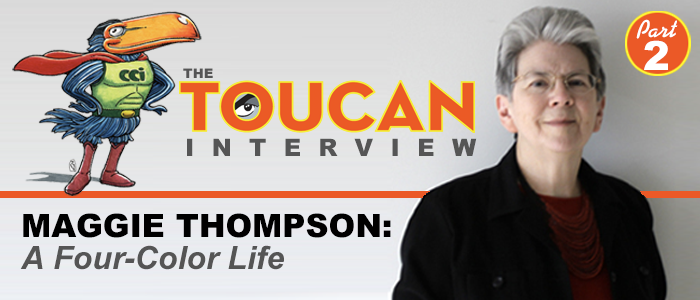
Toucan: What was the process of putting a fanzine together like for you and Don? Was there a definite delineation of duties?
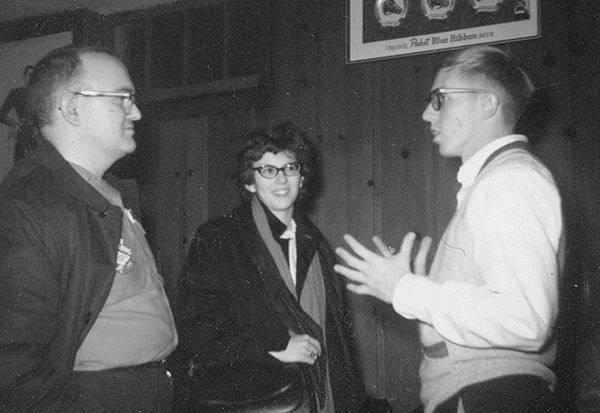
Maggie: Well, in the early issues he was technically listed as the editor and I was technically I think the—I don’t know what I was called—the illustrator. I cut all the mimeograph stencils. That is a skill by the way. I can do that to this day. If you bring a mimeograph stencil to me, by golly I can cut that stencil, and it’s tricky. And it’s not a spirit duplicator stencil. It is a mimeograph stencil, two very different things. And that was another differentiation. We published on mimeograph; most of the comics fans published on ditto because their schools had ditto machines and you could do multiple colors. There was a big thrill if you could get ditto masters from South Africa, because they actually had yellow ditto masters, so you could do yellow colors. You could do multiple colors in addition to the purple of the usual spirit duplication.
So what was the process like? What we did was the same sort of process we did that everybody did with their science fiction fanzines, which is you announced you were going to do it, you sent it out at a loss, made up for it in volume. Every issue we lost money, but as we say, we made up for it in volume. Our first issue is actually online at my website, and you can see just how little we had to go on in that first one. For example, we got a copy of the Comics Code and a lot of people hadn’t seen that, so we printed that, provided people a look at what was going on with comics that were then being censored. This was 1961, so the Code had been in effect for a while. We did quotes from books about comics, we did an editorial, which said we were looking for articles, and we sent that out to the science fiction fans who had expressed an interest, primarily through Xero, but also Bill Thailing put us in contact with people, and Dick and Pat Lupoff put us in contact with people. We sent copies to the [comic book publishers’] editorial offices. We’d find the name of an editor and we’d send it to the editor at whatever the comic book company was and say, “Gee, hope you’re interested in this!” And then we put on the back “Here’s why you’re getting this issue,” and it would list you paid for it, you’re an editor, you’re a professional in the field, you’re a fan, you have a letter in the issue, or whatever. And then people would send letters of comment. So we had a letters column in the next issue and people started contributing. So if you get an article by Harlan Ellison about comic books, you’re certainly going to be printing that.
I cut all the illustrations, we both did the typing, and there was Don’s editorial, which was, I think, called “The Word” and I think my editorial was called “And,” and so it went. We would cut the stencils and then I would get stuck with running a lot of it off because Don had a day job as a newspaper reporter, later an editor. So then it’s the collating and the stapling and the mailing. We had announced an “irregular publication schedule,” which is why the next issue was not late. I actually have in my attic somewhere the cover of the next issue, and I think a four-page story, maybe a six-page story, by George Metzger. The cover is by Vaughn Bodé, by the way. At some point I hope to turn it up because we sent those out to be printed. We thought in both those cases they shouldn’t be mimeographed, they should be printed. So we sent those out, and as I say somewhere in my attic there are the pages with a cover and a story by George Metzger, who was a wonderful underground cartoonist, a very inventive artist.
Toucan: He did Moondog.
Maggie: Yeah it was Moondog. But he also did a bunch of others. He was part of a fun communication at the time. When we finally started, Jerry Bails and Roy Thomas, and then later other editors, were doing things like “On the Drawing Board,” which had news of what was coming out in comics. The one thing that we felt was lost out of that aspect was fan contact. So there was another community that needed to be served. So we started a publication called Newfangles which was just things like so and so has moved, here’s his new address, and eventually that morphed into a the fanzine that we did regularly. Comic Art was irregularly published. Newfangles was on a regular announced publication schedule, and we were never late. And we had all the addresses. At one point I believe George Metzger and Steve Englehart were at the same Army base. So we dropped a note to, I believe, Englehart saying, “Hey, did you know that there’s another comics fan on the base with you?” And no he didn’t, so we put them in contact with each other, which was kind of a fun thing you could do back in that day. But every letter from Metzger was an embellishment. I mean he drew the envelopes, he would do comic book stories inside in his letters, and that sort of thing. There’s a huge backlog of Metzger stuff that’s never been printed that somebody needs to do someday.
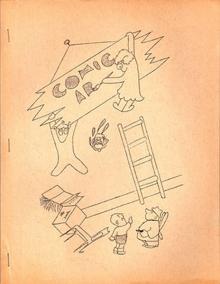
Toucan: So when you sent these fanzines to editors, such as Julie Schwartz and Stan Lee, what was their response?
Maggie: Very sweet, very positive. Julie asked us if we wanted to have our address publicized and we said absolutely not, because as noted we lost money on every issue. All we wanted was that wonderful cream of the crop circulation that we had, but they were very kind. They were very participatory, very friendly, very accessible, just so wonderful, partly I think because Julie, for example, had come out of science fiction and basically knew how to handle that sort of thing. Stan Lee was just always overwhelmed with work but was very kind. Bill Harris at Gold Key was wonderful. Again we had the advantage of being grown up, so we weren’t just coming and saying, “Hi, please send us original art.” It was much more; we were after the information, what was coming out, what were the plans, etc., and the fact that we would analyze, could analyze stuff with a certain amount of historical perspective that some others lacked.
Toucan: Let’s talk a little bit about the historical aspect of comics, because Don co-edited All in Color for a Dime and its sequel The Comic Book Book with Dick Lupoff.
Maggie: Well, they grew out of Xero, Dick’s magazine with Pat Lupoff, and Don did the article “Okay Axis Here We Come,” which was about the Timely Comics superheroes. He also did “The Wild Ones,” which was on fantasy superheroes. And Dick and Don together did an article on, I think, the aviation characters. So they were used to working together. Dick and Pat were friends with Terry Carr, who was working at Ace Books, and Ace wanted to publish it as a paperback and through Dick’s agent I believe—maybe through Terry’s agent—anyway presold it as a hardcover, so Ace would do it as a reprint. It was sold to Arlington House to do the hardcover of All in Color for a Dime. And then we did almost the reverse with The Comic Book Book, which was the sequel. We sold that to Arlington House for the Nostalgia Book Club, and that went to a different paperback book publisher [for the reprint].
The premise of All in Color for a Dime, as it originally began in Xero, was so you think the Green Turtle is the best hero that ever was in comics, do an article about what he was and why you think he was so great. That was the goal of each article. So they were deeply nostalgic and as informative as could be based on probably not having all the issues featuring the Green Turtle. Frequently you would find a writer going, “And in issue 17 he did blah, blah, blah,” and this didn’t mean that they had issues 1 through 16 or 18 on, but it was very much an emotional here’s why this is such a great character.
Toucan: But in the time span when these books came out there was a huge interest in nostalgia. I can remember walking into stores and seeing things like W.C. Fields and Marx Brothers posters and even trashcans. Do you think with these books you reached a larger more mainstream audience?
Maggie: Oh, I know we did, just because of the responses that I’ve had in the years since. People were saying “All in Color for a Dime was the first thing I ever saw that told me fascinating things about comics. It was so great I started to collect comics because it was this great book.” And I think that was part of the basic outreach of the field at that time. Again, there wasn’t a lot. I mean there were things, but a lot of popular culture was very transitory. If you didn’t see that movie in that theater that week, it was gone. If you didn’t buy that comic book that week, it was gone, and so forth, and so it was like trapping lighting in a bottle to say here’s a more permanent forum where we can talk about this, that, or the other. Of course, Jules Feiffer’s The Great Comic Book Heroes was wow, here were reprints of stories we’d never seen. What a thrill that was back in the day, and it’s still a thrill.
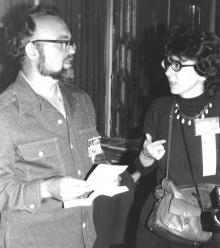
Toucan: Was there a time period then between when you started writing for Alan Light and the beginning of The Buyer’s Guide to Comics Fandom where you and Don weren’t publishing fanzines?
Maggie: Well, we did Comic Art and Newfangles. In fact, it was at Comic-Con in 1976 that Alan Light told about how he had created the Buyer’s Guide in an anecdote we had not heard, which said that we were responsible for Buyer’s Guide, which we hadn’t known until he said it on a panel. Basically, we had forgotten when we decided that we really didn’t want to do a newsletter anymore. As I said, we did Newfangles on a regular schedule. We decided it was a pain in the ass to do because it was a monthly at that point and it just was exhausting. So we said all right, we’re going to show the kids how you close a magazine. We are going to say when it ends, we are going to do a countdown. We are going to refund any subscription money we have over that amount. It was a several-month lead-in to that last issue, and we didn’t take the money and run. We’re doing the countdown and then the last issue will say this is the last issue. That gives somebody else time to replace it, and indeed that is what happened. Paul Levitz and Paul Kupperberg were doing a fanzine that was similar to what we were doing. We said, you know what? This is a great fanzine. Everybody who likes Newfangles should now support that magazine. So it lent stability to the process that we were very happy about.
In the course of all that, one of the things that happened was that this high school kid, Alan Light, contacted us, and said, “I understand that the publication and the distribution is nothing you’re enjoying. How about if I do that and you just provide the text. I’ll do the publication and handle all the rest of the things you don’t like to do.” And we, in far more polite terms than I’m expressing here, said, “Get lost kid, you bother us.” So there was Alan. He had the money that he’d saved and was all ready to publish our magazine. He knew that his local shopper newspaper was called Buyer’s Guide, and he kind of thought maybe we could be a Buyer’s Guide for Comic Fandom, and he created it. He started that as an advertising vehicle like his local buyer’s guide, but it was for buying and selling and promoting comic books. We did not know until he said at that panel that the reason he started it was that we had turned him down.
Toucan: What was the name of the Levitz and Kupperberg fanzine?
Maggie: It was Etcetera.
Toucan: And did that eventually morph into Comic Reader?
Maggie: No, Comic Reader began long before that. I don’t remember exactly when they had started it, but it had sort of existed already and then they developed it, sent us a copy—we probably were already getting it—but sent us a copy and we said yeah, that absolutely would serve the same purpose that we were serving. So as I say, we endorsed that. And I don’t know whatever happened to Levitz and Kupperberg. I don’t know if they stayed in the field or not [laughter]. In fact, we remain good friends to this day.
Toucan: Eventually though, you relented and you and Don did start writing for Alan Light.
Maggie: Yes.
Toucan: I have it as issue 19 in August of 1972.
Maggie: Yes. And actually I did a spot illustration for somebody else’s column and I’m pretty sure it was Tony Isabella. I think I had a picture in #4. But yes, we started our column and it was the issue almost simultaneous with the birth of our son.
Toucan: So about 12 years after that, you and Don are actually the editors, because Alan Light sells it to Krause. How did all that come about?
Maggie: Well, the Cleveland Press went out of business in the summer of 1982 and we freelanced for a few desperate horrendous months of terror. Don was trying to get work in the Cleveland area and, of course, every other journalist who worked for the Cleveland Press was also out of work, so it was not a great time to try to find a job. And we signed up with Kelly Girls [a temp agency]. We did some freelancing. I had created a magazine called Fantasy Empire for Hal Schuster of New Media Publishing, who also did Comics Feature. My boss was Carol Kalish [later the Direct Sales manager for Marvel Comics]. And Hal had wanted to do a magazine devoted to Doctor Who and that was one of the things that I had been writing about in Beautiful Balloons and Buyer’s Guide. And he said I want to create a magazine, I want to call it Doctor Who Magazine and I want you to edit it, and I said they will break your legs. You can’t do a Doctor Who Magazine, but what if we call it Fantasy Empire and it’s about fantasy and science fiction in the British Empire and we feature Doctor Who strongly in our covers, content, etc.? And he said that sounded peachy to him. So we had that assignment and it even included doing the layout, paste-ups, etc. Then Carol went to work for Marvel and I working directly for Hal and his brother, Jack, and it was not enough to pay the bills, I can assure you. So we were going through our savings at a pretty good clip.
And then Chet Krause at Krause Publications contacted Alan Light because he wanted to diversify his collector publications. Chet had created Numismatic News, which was for coin collectors. He had diversified into another of his hobbies, so in addition to that he was also doing Old Cars Weekly and Sports Collectors Digest, and so forth. He was trying to diversify into various collecting fields and negotiated with Alan to buy the Buyer’s Guide for Comic Fandom and Film Collector’s World and we did columns for both of those. He wanted someone with professional publishing experience to turn them both into basic newspapers and we were qualified and came for an interview and Chet kept shaking his head because he said he didn’t know how a husband and wife could work together on anything, and we said well we’ve been doing it a long time. It actually changed the company policy. Before we were hired Krause Publications couldn’t have a husband and wife working for the company. If there was a romance and there was a marriage, one of the couple had to leave the company. So that changed the policy and there were several marriages within the next few months once we had joined the company. We turned them both into newspapers and went through all the excitement that involved staying for long, long hours, because suddenly we were going from typing the material to typesetting the material and suddenly it was thousands of words in an issue instead of a few hundred and we did it and yay.
Toucan: And at that point it was a weekly publication, right?
Maggie: Yes, absolutely.
Toucan: Was it weekly when Alan sold it?
Maggie: Yes, but it had editorial content only in every other issue. So one issue would have all ads and the next issue would have 25% editorial content in addition, in order to maintain the second-class mailing privilege.
Toucan: So you basically have been involved with that for the last almost 30 years?
Maggie: Our first day at Krause Publications was January 3, 1983. The day the conference call came to announce its cancellation was January 3, 2013, exactly 30 years. And obviously there had been a decade before that when we were working on Buyer’s Guide when Alan did it.
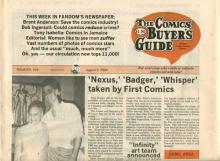
Toucan: You’ve seen the comics industry change drastically over all those years. When you go to something like Comic-Con, how does that make you feel about how fandom has grown and how comics are really cool to a much larger audience?
Maggie: It’s very exciting because it’s always been an artform, and the challenge has been to let other people know that it’s an artform to be respected. I believe it was Harvey Pekar who said there is no limit to how good the words can be and no limit to how good the pictures can be. So you can have tremendous achievements in creating comics. It has always had that potential. And it is finally realizing that potential in so many exciting ways. If you attend the Eisner Awards and you see some of the material that’s there—including material you may not have noticed until you’re sitting there—oh, my gosh that is fantastic, it’s a tremendous feeling, it’s an exciting feeling, and there’s no limit to how good it can be.
Toucan: With all those issues of CBG, do you have a favorite story or a favorite issue that stands out?
Maggie: I’ve been asked that before and it’s very embarrassing that I really can’t . . . it’s just all been so tremendous. I mean, seeing submissions from fans and professionals. I didn’t know until Comic-Con a few years ago that we had published the only work by James Owens [Starchild] that was never published elsewhere, so we had the only printing of that particular work. When Peter Laird and Kevin Eastman used to do filler cartoons for us and then went on to do Teenage Mutant Ninja Turtles. The Hernandez Brothers did filler cartoons for us back when we were writing for Alan. Goodness, I am very embarrassed that I actually cannot pick a favorite. There’s been so much excitement over the years.
I will say of the sort of fun that we’ve had in Movie Collector’s World that was sold years and years ago by Krause Publications to another publisher. But back when we were doing that there was a discussion of Plan 9 from Outer Space as being the worst movie ever. It was the iconic worst movie, and science fiction writer Lawrence Watt-Evans was doing an article for us and he said that Creature of Destruction was worse than Plan 9 from Outer Space and he referred to the bland acting of actor Aaron Kincaid. He referred to that in the article and we got a submission from Aaron Kincaid saying “Bland?!” He said blind would be more like it—and I’m paraphrasing now—he said “I was blind drunk during the filming of that movie!” and it was just a hilarious contribution from Mr. Kincaid. It was just delicious. And it’s the kind of thing that happens when you’re publishing for popular culture. People are reading it and you don’t know they’re reading it. People respond to it in ways that you have no idea of and it’s just a delight. Just as I say at Comic-Con you can’t possibly know what an influence you are because people are meeting there, they’re greeting there, they’re striking up acquaintances, they’re coming up with ideas that are going to become full-fledged projects, and you will never know the impact that you had. It’s much the same thing with what we’ve done in our career and what I hope we’ll continue to do.
Toucan: I want to end with a quote from your friend Heidi MacDonald from an article she wrote about the demise of Comics Buyer’s Guide, which said, “I’ve said it many times, Maggie is my role model. I want to be as smart and inquisitive and engaged as she is everyday of my life.”
Maggie: You’re choking me up. People have been wonderful and will continue to be wonderful, and we are in an exciting world and we don’t know where it’s going, but by golly, it’s dog-gone wonderful.
There’s more Maggie to come on Toucan! Tune in the first Tuesday of each month for her ongoing column, Maggie’s World. You can also visit her on the web at www.maggiethompson.com